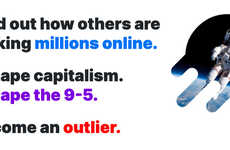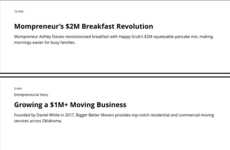
Joanne Lam — March 7, 2011 — About
References: sbnonline
As businesses begin to rise up once more following the recent recession, Jeremy Gutsche was interviewed on Smart Business in regards to his book EXPLOITING CHAOS, which features many examples of how opportunity often comes from the chaotic events in society.
Providing his views on how businesses like Fortune magazine have grown through the Great Depression, Gutsche reiterates that it is through understanding consumer needs that companies manage to grow during the toughest of times. As he states in his book, it is during this period of urgency that individuals are able to take the risks necessary for their businesses to prosper.
03.01.2011 | Andrew B. Clancy
The global financial crisis that began in 2008 brought a sudden end to a number of businesses. However, according to Jeremy Gutsche, author and founder of TrendHunter.com, history suggests that a great business of the future will trace its roots back to the darkest days of the past three years. The reason is that many companies that struggle do so because they get too caught up with the day-to-day routine of getting through the crisis and forget the importance of really understanding the changes that are taking place. In this interview, Gutsche discusses his book, “Exploiting Chaos,” why Fortune magazine was able to succeed during the Great Depression and the reason that culture beats strategy.
You profile Fortune magazine in ‘Exploiting Chaos.’ Why was it able to succeed despite being launched during the Great Depression?
Fortune magazine is particularly interesting to me because the magazine was launched just four months after the 1929 Wall Street crash. It was priced at $1 an issue, which in that day made it the same price as a wool sweater. A price of $1 an issue made it more expensive than any magazine that had been on the scene at that point. But during the Great Depression, it grew its subscriber base to half a million people. They made about $7 million in modern-day profit.
Why that’s interesting is not that it was a luxury publication during such a difficult time, but rather that Fortune followed a new consumer need. If you put yourself in the mindset of people during the 1930s, they were trying to figure out what happened to our economies. For the first time, the decisions that put people in economic hardship were caused by corporations that were operating behind boardroom doors. Fortune offered a glimpse into what was happening behind those boardroom doors. How did we get here and when would we emerge? Like many of these other success stories, [Fortune’s story] is simply an example of a company that was able to spot new opportunities and consumer needs and, thereby, reinvent.
At one point, you discuss your own experience as head of Capital One Canada’s up-market lending business. You were given an odd goal: Don’t let profits decline by more than 20 percent. What did this crisis teach you, and how did you turn this business around?
This period of crisis really enabled us to cut through the red tape. Instead of having a couple of weeks to get legal or compliance approval, now suddenly, you could get it a little bit quicker because they had to cut out the unnecessary steps. This need to change can be used by companies when you’re trying to think about how to really compel people to move and try new things. You can use that external economic motivator, that crisis flag, as a way to really create a sense of urgency.
I got my entire team to set up booths across Canada where, if you went to the Capital One booth, you were actually talking to a marketer or an ad agency rep or a finance person. Their purpose was to work the booth so we could just talk to customers and really understand how consumer needs had evolved. As a result, we ended up launching new products and with that red tape cut, we could get them out a little faster. Instead of shrinking the business by only 20 percent, we tripled our monthly bookings and that business went on to become a billion-dollar business.
For me, the interesting takeaway wasn’t the general idea of how you should reinvent a product. It was the idea that the sense of urgency, the customer obsession and that crisis can actually help you to create miraculous things.
Exploiting Chaos: 150 Ways to Spark Innovation During Times of Change
By Jeremy Gutsche
©2009 HarperCollins, 272 pages, $20
About the book: “Exploiting Chaos” offers readers 150 strategies to spark innovation and reinvention during difficult economic times. Author Jeremy Gutsche argues that turbulent economic periods present windows of opportunity. He examines historical examples of companies that successfully innovate during crisis periods and provides a detailed four-part plan to accomplish the seemingly impossible.
The author: Jeremy Gutsche is an innovation expert and the founder of TrendHunter.com, the world’s largest network for trend spotting and innovation. Gutsche has appeared in the pages of The Economist and The Financial Times as well as on “Entertainment Tonight” and Fox News.
Why you should read it: Gutsche presents information in a rapid-fire fashion, but the accompanying stories are so memorable that a reader won’t need a notepad. His focus on customer obsession is a much-needed message for businesses looking to distinguish themselves in today’s global economy. Gutsche’s expertise on innovation means readers receive a comprehensive set of ideas delivered with unparalleled authority.
Why it’s different: The book’s design stands out against the majority of business books available in today’s market. Its large type and eye-catching use of photographs make it instantly engaging. Gutsche offers one of the most powerful arguments for a shift from strategy to culture. This idea is gaining ground, and “Exploiting Chaos” will no doubt help the movement. Businesses that want to improve their innovation strength would do well to heed Gutsche’s revolutionary call.
Can’t miss: “Observe in the Zone” — In this example, Gutsche writes about the experiences of John Manoogian, Cadillac’s head of external design. Cadillac was taken by surprise when the Escalade, an SUV designed for older, affluent males, became the dominant symbol of hip-hop culture. What Manoogian did to learn more about this audience will leave some readers in disbelief. It’s a powerful lesson in customer obsession.
To share or not to share: The format of “Exploiting Chaos” makes the book perfect for sharing. In fact, Gutsche’s short, explosive chapters could easily be adapted into blog posts or a page-per-day calendar.
Providing his views on how businesses like Fortune magazine have grown through the Great Depression, Gutsche reiterates that it is through understanding consumer needs that companies manage to grow during the toughest of times. As he states in his book, it is during this period of urgency that individuals are able to take the risks necessary for their businesses to prosper.
Finding innovation in chaos
03.01.2011 | Andrew B. Clancy
The global financial crisis that began in 2008 brought a sudden end to a number of businesses. However, according to Jeremy Gutsche, author and founder of TrendHunter.com, history suggests that a great business of the future will trace its roots back to the darkest days of the past three years. The reason is that many companies that struggle do so because they get too caught up with the day-to-day routine of getting through the crisis and forget the importance of really understanding the changes that are taking place. In this interview, Gutsche discusses his book, “Exploiting Chaos,” why Fortune magazine was able to succeed during the Great Depression and the reason that culture beats strategy.
You profile Fortune magazine in ‘Exploiting Chaos.’ Why was it able to succeed despite being launched during the Great Depression?
Fortune magazine is particularly interesting to me because the magazine was launched just four months after the 1929 Wall Street crash. It was priced at $1 an issue, which in that day made it the same price as a wool sweater. A price of $1 an issue made it more expensive than any magazine that had been on the scene at that point. But during the Great Depression, it grew its subscriber base to half a million people. They made about $7 million in modern-day profit.
Why that’s interesting is not that it was a luxury publication during such a difficult time, but rather that Fortune followed a new consumer need. If you put yourself in the mindset of people during the 1930s, they were trying to figure out what happened to our economies. For the first time, the decisions that put people in economic hardship were caused by corporations that were operating behind boardroom doors. Fortune offered a glimpse into what was happening behind those boardroom doors. How did we get here and when would we emerge? Like many of these other success stories, [Fortune’s story] is simply an example of a company that was able to spot new opportunities and consumer needs and, thereby, reinvent.
At one point, you discuss your own experience as head of Capital One Canada’s up-market lending business. You were given an odd goal: Don’t let profits decline by more than 20 percent. What did this crisis teach you, and how did you turn this business around?
This period of crisis really enabled us to cut through the red tape. Instead of having a couple of weeks to get legal or compliance approval, now suddenly, you could get it a little bit quicker because they had to cut out the unnecessary steps. This need to change can be used by companies when you’re trying to think about how to really compel people to move and try new things. You can use that external economic motivator, that crisis flag, as a way to really create a sense of urgency.
I got my entire team to set up booths across Canada where, if you went to the Capital One booth, you were actually talking to a marketer or an ad agency rep or a finance person. Their purpose was to work the booth so we could just talk to customers and really understand how consumer needs had evolved. As a result, we ended up launching new products and with that red tape cut, we could get them out a little faster. Instead of shrinking the business by only 20 percent, we tripled our monthly bookings and that business went on to become a billion-dollar business.
For me, the interesting takeaway wasn’t the general idea of how you should reinvent a product. It was the idea that the sense of urgency, the customer obsession and that crisis can actually help you to create miraculous things.
Exploiting Chaos: 150 Ways to Spark Innovation During Times of Change
By Jeremy Gutsche
©2009 HarperCollins, 272 pages, $20
About the book: “Exploiting Chaos” offers readers 150 strategies to spark innovation and reinvention during difficult economic times. Author Jeremy Gutsche argues that turbulent economic periods present windows of opportunity. He examines historical examples of companies that successfully innovate during crisis periods and provides a detailed four-part plan to accomplish the seemingly impossible.
The author: Jeremy Gutsche is an innovation expert and the founder of TrendHunter.com, the world’s largest network for trend spotting and innovation. Gutsche has appeared in the pages of The Economist and The Financial Times as well as on “Entertainment Tonight” and Fox News.
Why you should read it: Gutsche presents information in a rapid-fire fashion, but the accompanying stories are so memorable that a reader won’t need a notepad. His focus on customer obsession is a much-needed message for businesses looking to distinguish themselves in today’s global economy. Gutsche’s expertise on innovation means readers receive a comprehensive set of ideas delivered with unparalleled authority.
Why it’s different: The book’s design stands out against the majority of business books available in today’s market. Its large type and eye-catching use of photographs make it instantly engaging. Gutsche offers one of the most powerful arguments for a shift from strategy to culture. This idea is gaining ground, and “Exploiting Chaos” will no doubt help the movement. Businesses that want to improve their innovation strength would do well to heed Gutsche’s revolutionary call.
Can’t miss: “Observe in the Zone” — In this example, Gutsche writes about the experiences of John Manoogian, Cadillac’s head of external design. Cadillac was taken by surprise when the Escalade, an SUV designed for older, affluent males, became the dominant symbol of hip-hop culture. What Manoogian did to learn more about this audience will leave some readers in disbelief. It’s a powerful lesson in customer obsession.
To share or not to share: The format of “Exploiting Chaos” makes the book perfect for sharing. In fact, Gutsche’s short, explosive chapters could easily be adapted into blog posts or a page-per-day calendar.
Read the full interview on Smart Business HERE!
Trend Themes
1. Innovation During Economic Crisis - The global financial crisis presents opportunities for businesses to innovate and thrive, as demonstrated by companies like Fortune magazine during the Great Depression.
2. Understanding Consumer Needs - Understanding consumer needs is crucial for businesses to grow and succeed during tough economic times, as highlighted by Jeremy Gutsche in his book 'Exploiting Chaos'.
3. Culture Over Strategy - The importance of culture in driving innovation and success is emphasized by Gutsche, providing businesses with an opportunity to shift their focus from strategy to culture.
Industry Implications
1. Publishing - The publishing industry can benefit from finding new consumer needs and reinventing their offerings, as exemplified by Fortune magazine during the Great Depression.
2. Finance - The finance industry can leverage crisis situations and create a sense of urgency to drive innovation and understand evolving consumer needs, as demonstrated by Capital One Canada's up-market lending business.
3. Innovation Consulting - The innovation consulting industry can provide strategies and guidance to businesses on how to spark innovation and reinvention during difficult economic times, as outlined in Jeremy Gutsche's book 'Exploiting Chaos'.
0.4
Score
Popularity
Activity
Freshness























